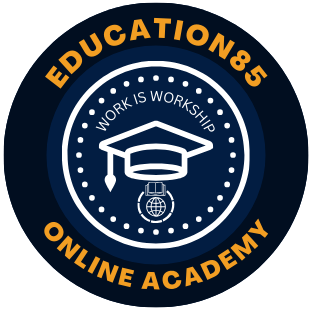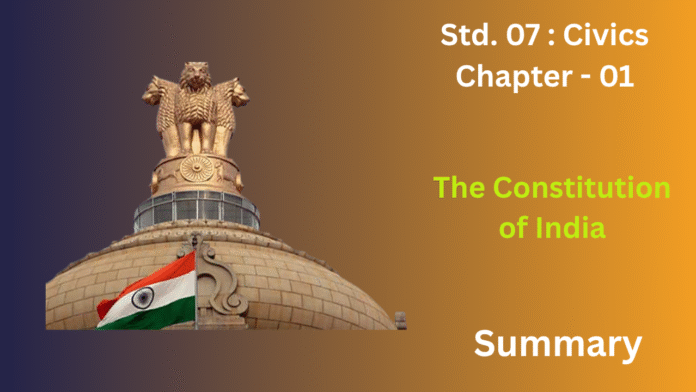The chapter would likely elaborate on the genesis of the Indian Constitution, mentioning the Constituent Assembly, its prominent figures, and the duration of the drafting process. It might underscore the complexities encountered during its formation, such as the nation’s division and its inherent diversity.
A substantial segment would probably focus on the Preamble to the Constitution, elucidating its core values such as justice, liberty, equality, fraternity, and India’s character as a secular, democratic, and republic state. These are presented as the overarching tenets and aims of the Constitution.
The chapter would also likely address the Fundamental Rights guaranteed to all individuals, encompassing the right to equality, freedom of speech and expression, right to life and personal liberty. These are portrayed as indispensable for individual dignity and progress.
Lastly, the chapter might briefly introduce the Directive Principles of State Policy, which are guiding principles for the government in formulating laws and policies to ensure social and economic equity, although these are not legally binding. The significance of the Constitution in securing a well-governed and equitable society would likely be highlighted.
In summary, the chapter aims to impart a basic comprehension of the Indian Constitution as the bedrock legal and political text of the country, outlining its key attributes, objectives, and the rights and obligations it confers upon its citizens and the government.
Time To Learn
A. Fill in the blanks:
1. Dr. B.R. Ambedkar was the chairman of_______________ committee of the constitution.
Ans: Drafting
2. __________________ was the chairman of the Constituent Assembly.
Ans: Dr. Rajendra Prasad
3. The Constituent Assembly took about _____________________________ to complete its work.
Ans: 2 years 11 months and 18 days
4. The Preamble is an _____________ to the Constitution.
Ans: introduction
5. The constitution came into force in the year ___________ .
Ans: 1950.
B. Match the contents of Column A with those of Column B
Column A Column B


Ans:

III. Tick mark (✓) the cor (X) the wrong ones.
- Constitutiion is the supreme law of the land.
✓ - Before independence, our country was governed according to our Constitution.
X
After independence, our country was governed according to our Constitution. - Our country became a Sovereign Democractic Republic on 15 th August, 1947.
X
Our country became a Sovereign Democractic Republic on26th January, 1950. - In India, the son or daughter of the President succeeds him after his death.
X - In India, all religions are equally respected.
✓ - Elections to the Parliament and state legislatures are held every five years
✓
Answer the following:
Question 1.
What do you mean by the term ‘Constitution’? What does it contains?
Ans:
A Constitution is a country’s fundamental law, outlining the government’s structure, its relationship with the people (including rights), and the nation’s guiding principles. It’s the supreme legal document, acting as the blueprint for governance. It typically contains a preamble, details on the organization of government, fundamental rights, and often directive principles and amendment procedures.
Question 2.
Why is it necessary to have a Constitution for a country?
Ans:
A Constitution is vital because it structures the government, guarantees fundamental rights, limits government power, provides a legal basis, reflects national values, ensures stability and order, promotes the rule of law, and defines citizenship. It’s the essential framework for a just and well-governed country.
Question 3.
Name the body that framed the Constitution of India. Who was its chairman?
Ans:
Constituent Assembly framed India’s Constitution. Its permanent Chairman was Dr. Rajendra Prasad.
Question 4.
Who represented the Anglo-Indians and the Parsees in the Constituent Assembly?
Ans:
- For the Anglo-Indian community, the primary representatives were Frank Anthony and S.H. Prater.
- The Parsee community was represented by Sir Homi Pherozshaw Modi, often referred to as H. P. Modi.
Question 5.
What is Preamble? Why is it important?
Ans:
The Preamble is the introduction to a constitution, stating its core values, goals, and objectives. It’s important because it shows the source of authority, sets out national aims, reflects the philosophy, helps in interpretation, highlights the nature of the state, gives identity and purpose, and holds symbolic significance as the constitution’s heart and soul.
Question 6.
What are the main ideals contained in the Preamble to the Constitution of India?
Ans:
The Indian Preamble establishes India as an independent, socially conscious, religiously neutral, people-governed republic. Its objectives are to ensure fairness (social, economic, and political), freedom, equal status, and a sense of brotherhood that respects individual worth and national unity.
Question 7.
Define the following: (a) Sovereign State (b) Secular State (c) A Republic
Ans:
(a) Sovereign State: Supreme, independent authority over its territory and people, free from internal/external control.
(b) Secular State: Officially neutral on religion, treats all equally, separates state and religion, ensures freedom of conscience.
(c) Republic: Head of state is elected, not hereditary; power usually held by elected representatives.
Question 8.
State the difference between a democracy and a republic.
Ans:
Democracy: Power by the people (directly or through elections), majority rule, political equality.
Republic: Head of state is elected (not hereditary), rule of law, governance by elected representatives, focus on public good and often protection of individual rights.
Key difference: Republic emphasizes elected leaders bound by law, while democracy emphasizes the will of the people. Modern republics are usually democratic.
Question 9.
Do you think Indian government is ‘of the people, by the people and for the people’?
Ans:
The Indian government is ‘of the people’ and ‘by the people’ through elections and citizen involvement. However, whether it consistently operates ‘for the people’ is complex, facing challenges in representation, diverse influences, implementation issues, and ensuring benefits reach all citizens equally. While the structure aims to serve the people, the reality is a continuous process with both successes and areas for improvement.
Additional Questions
(The Constitution of India)
A. Fill in the blanks:
1. The Constitution of India was framed by the _________________________ .
Ans: constituent Assembly.
2. The Preambles tell us about the ___________ of the Constitution, the __________ of the state and its main objectives of the Constitution.
Ans: source , nature
3. Socialism involves ________ distribution of the country’s wealth among _____ sections of the people.
Ans: fair , all
4. The people of India elect their own government because India is a _____________ country.
Ans: Democratic
5. The President of India has a fixed term of ___________ .
Ans: 5 years.
B. Match the following:


Answer:

C. Choose the correct answer:
1. India won freedom from British/French/Portuguese rule on 15 August 1947.
Ans.
India won freedom from British rule on 15 August 1947.
2. The chairman of the Constituent Assembly of India was Dr Rajendra Prasad/B. R.Ambedkar/Maulana Azad.
Ans.
The chairman of the Constituent Assembly of India was Dr Rajendra Prasad.
3. The source of the Indian Constitution is the President/the Prime Minister/the people of India.
Ans.
The source of the Indian Constitution is the people of India.
4. A democractic/socialist/secular state does not have an official religion.
Ans.
A secular state does not have’bn official religion.
5. A democracy can work only if there is a spirit of jealousy/ brotherhood/competition among the different sections of society.
Ans.
A democracy can work only if there is a spirit of brotherhood among the different sections of society.
D. State whether the following are true or false:
- The Constitution of India was framed by the British government.
False.
Correct: The Constitution of India was framed by the Constituent Assembly.
- Sarojini Naidu was a member of the Constituent Assembly.
True. - The Preamble is the conclusion to the Constitution.
False.
Correct: The Preamble is the introduction to the Constitution.
- When the President of India dies, his/her son becomes the next President.
False.
- All Indian citizens are equal in the eyes of the law.
True.
E. Answer the following questions in one or two words/ sentences:
Question 1.
Define the term ‘constitution’.
Ans:
The term ‘constitution’ denotes the foundational legal framework of a nation. It stands as the supreme legal instrument, establishing the fundamental structure for the country’s governance. This encompasses outlining the organization of the government, the allocation of authority among its various components, the relationship between the governing body and its populace (including fundamental entitlements), and the overarching principles guiding the state. Consider it the blueprint or the core operational system for a country’s administration.
Question 2.
How do we know that the Constitution of India was not imposed on us by the British?
Ans:
The Indian Constitution wasn’t imposed by the British because:
- Indians demanded it: The independence movement called for a self-made constitution.
- Indians formed the assembly: The Constituent Assembly that drafted it was elected by Indians.
- Indians led the process: Key figures were Indian leaders committed to Indian ideals.
- Indians debated and decided: The Constitution was a result of extensive Indian discussions.
- India rejected British laws: The Constitution repealed previous British acts, asserting sovereignty.
- The Preamble states “We, the People”: This emphasizes Indian authorship and authority.
Question 3.
When did the Constitution of India come into force?
Ans:
The Constitution of India was enacted and became legally operative on January 26, 1950. This date is observed annually in India as Republic Day.
Although the Constituent Assembly formally adopted the Constitution on November 26, 1949, certain initial articles pertaining to citizenship, electoral processes, the provisional legislature, and related matters were implemented immediately on that date. However, the primary body of the Constitution, including its introductory Preamble, was enforced on January 26, 1950. This specific date was selected to commemorate the declaration of complete independence (Purna Swaraj) by the Indian National Congress, which occurred on the same day in 1930.
Question 4.
What is a preamble.
Ans:
A preamble is a brief introduction to a formal document, especially a constitution. It states the purpose, principles, and objectives the document aims to achieve and often indicates the source of its authority. It’s like a preface that reveals the document’s spirit and intent.
Question 5.
Who gives the government of India the authority to govern the country?
Ans:
The people of India give the government the authority to govern, as stated in the Preamble of the Constitution with the words “WE, THE PEOPLE OF INDIA…”.
F. Answer the following questions briefly:
Question 1.
Explain the meaning of the following terms:
(a) Sovereign (b) Democratic (c) Republic
Ans:
(a) Sovereign:
- Meaning: India possesses supreme and independent authority over its territory and its populace. It is free from any form of external control or subjugation by any foreign entity. The Indian government holds the ultimate power to formulate and implement laws and policies for the nation and its citizens, without being subject to the dictates of any other country or international organization.
- In essence: India has the inherent right to self-governance without external interference.
(b) Democratic:
- Meaning: The authority of the Indian government originates from the will of its people. This power is expressed through electoral processes where citizens select their representatives. The government is accountable to the citizenry, and individuals possess the right to participate in the nation’s political affairs.
- In essence: Ultimate power resides with the people, who exercise it through a system of elected representation.
(c) Republic:
- Meaning: The head of the Indian state is an elected official, the President, rather than a ruler who inherits their position through lineage (such as a king or queen). This signifies that ultimate authority rests with the people, who directly or indirectly choose their leaders, including the highest office in the country.
- In essence: There is no inherited head of state; the nation’s leader is a representative chosen by the people.
Question 2.
State the basic features of the following: (a) a socialist state (b) a secular state
Ans:
(a) Socialist State: Aims for social and economic equality through state control/regulation of resources, prioritizes social welfare, reduces inequality, and focuses on social needs over profit.
(b) Secular State: Neutral on religion, ensures equal respect for all faiths, guarantees freedom of religion, maintains separation of state and religion, and ensures impartial governance without religious bias.
Question 3.
State the objectives of the Constitution with reference to: (a) Justice (b) Liberty (c) Equality
Ans:
(a) Justice: The Constitution aims for social, economic, and political fairness for all citizens, eliminating discrimination and ensuring equal opportunities and rights.
(b) Liberty: It seeks to secure freedom of thought, expression, belief, faith, and worship for everyone, free from undue restrictions while respecting public order and morality.
(c) Equality: The Constitution strives for equal status and opportunity for all, abolishing privileges and ensuring everyone has fair chances regardless of background, with provisions for affirmative action to uplift marginalized groups.
Question 4.
Why did the farmers of the Constitution decide to promote fraternity among the people of India?
Ans:
Fraternity, as promoted by the framers of India’s constitution, served several key purposes:
- Bridging Divisions: It was intended to overcome deep-seated historical divisions like caste, religion, and regionalism. The framers saw it as a necessary principle to forge a cohesive national identity from a diverse population.
- National Unity: The concept of fraternity was crucial for ensuring the unity and integrity of the newly independent nation. It was meant to bind citizens together in a shared sense of purpose and belonging.
- Upholding Dignity: The framers linked fraternity directly to the dignity of the individual. They believed that true equality and liberty could only be achieved if every person was treated with respect and honor, which fraternity helps to foster.
- Social Cohesion: It was designed to strengthen the bonds of social cohesion, promoting a sense of mutual responsibility and care among citizens. This was seen as a foundation for a stable and harmonious society.
- Foundation for Core Values: Fraternity was considered the underlying principle that would make justice, liberty, and equality a reality. Without a sense of brotherhood, these ideals would remain abstract concepts rather than practical guarantees for every citizen.
- Building on Solidarity: The framers drew inspiration from the sense of solidarity and shared sacrifice that characterized the independence movement. Fraternity was meant to continue and formalize that spirit of collective struggle into a permanent constitutional value.
G Picture study:
This is a picture of the Chairman of the Constituent Assembly of India which drafted the Indian Constitution.

Question 1.
Identify the person in the picture.
Ans:
Dr. Rajendra Prasad.
Question 2.
Name two other prominent members of the Constituent Assembly.
Ans:
- B.R Ambedkar
- MaulanaAzad
Question 3.
When was the first meeting of the Constituent Assembly held?
Ans:
9 Dec 1946.
Question 4.
When did the Constitution come into force?
Ans:
26 January 1950
Question 5.
What is the introduction to the Constitution called? What does it tell us about the source of the Constitution?
Ans:
The Constitution’s introduction is the Preamble. It shows the Constitution’s authority comes from “WE, THE PEOPLE OF INDIA,” meaning the citizens are the ultimate source of power.
Question 6.
Mention the objectives stated in the introduction.
Ans:
The Preamble’s objectives are to make India a sovereign, socialist, secular, democratic republic and to secure justice, liberty, equality, and promote fraternity among its citizens, ensuring individual dignity and national unity.


